TOYOTA C-HR 2022 Owners Manual
Manufacturer: TOYOTA, Model Year: 2022, Model line: C-HR, Model: TOYOTA C-HR 2022Pages: 818, PDF Size: 113.75 MB
Page 461 of 818
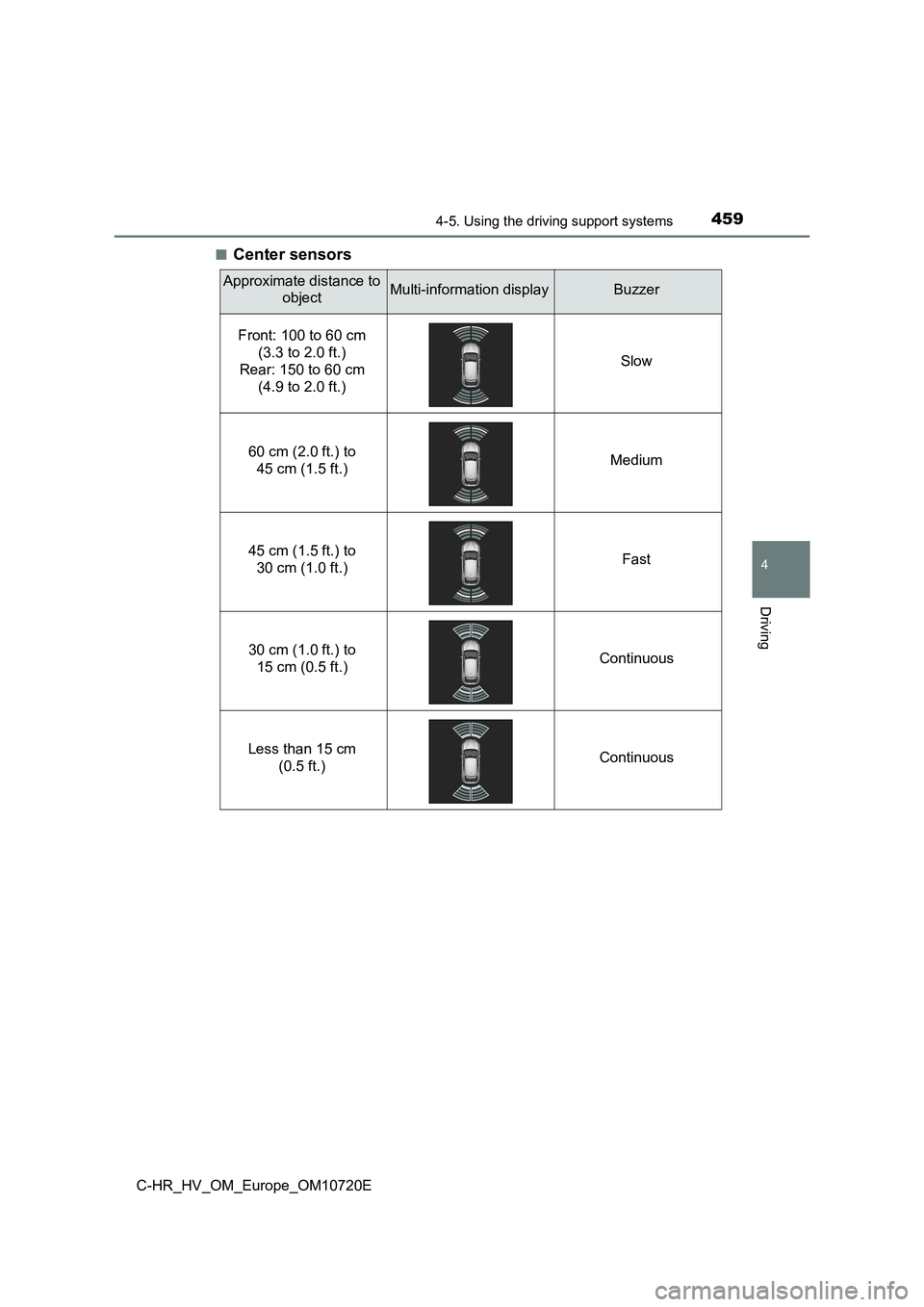
4594-5. Using the driving support systems
4
Driving
C-HR_HV_OM_Europe_OM10720E
■Center sensors
Approximate distance to
objectMulti-information displayBuzzer
Front: 100 to 60 cm
(3.3 to 2.0 ft.)
Rear: 150 to 60 cm
(4.9 to 2.0 ft.)
Slow
60 cm (2.0 ft.) to
45 cm (1.5 ft.) Medium
45 cm (1.5 ft.) to
30 cm (1.0 ft.) Fast
30 cm (1.0 ft.) to
15 cm (0.5 ft.) Continuous
Less than 15 cm
(0.5 ft.) Continuous
Page 462 of 818
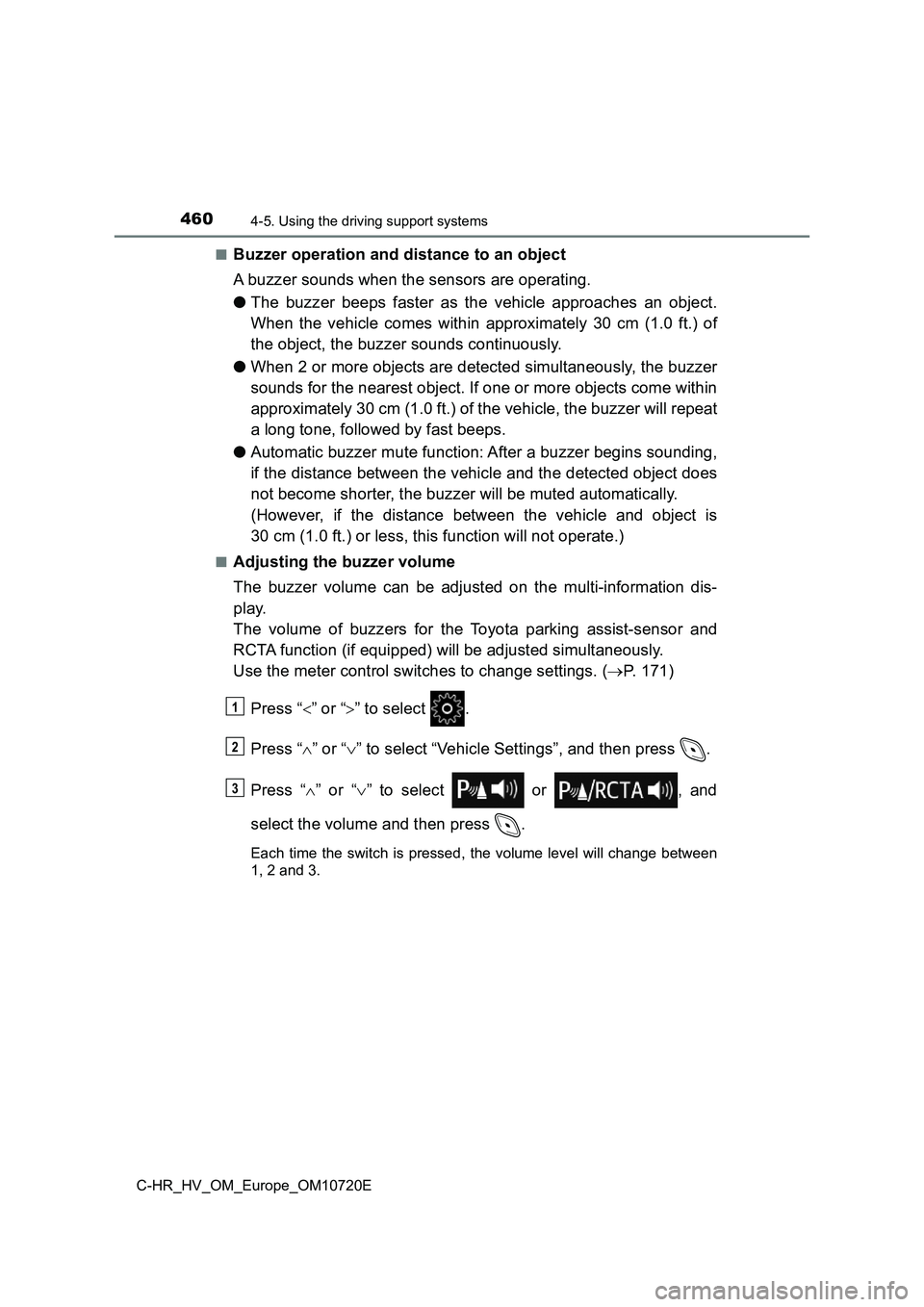
4604-5. Using the driving support systems
C-HR_HV_OM_Europe_OM10720E
■Buzzer operation and distance to an object
A buzzer sounds when the sensors are operating.
● The buzzer beeps faster as the vehicle approaches an object.
When the vehicle comes within approximately 30 cm (1.0 ft.) of
the object, the buzzer sounds continuously.
● When 2 or more objects are detected simultaneously, the buzzer
sounds for the nearest object. If one or more objects come with in
approximately 30 cm (1.0 ft.) of the vehicle, the buzzer will r epeat
a long tone, followed by fast beeps.
● Automatic buzzer mute function: After a buzzer begins sounding,
if the distance between the vehicle and the detected object doe s
not become shorter, the buzzer will be muted automatically.
(However, if the distance between the vehicle and object is
30 cm (1.0 ft.) or less, this function will not operate.)
■Adjusting the buzzer volume
The buzzer volume can be adjusted on the multi-information dis-
play.
The volume of buzzers for the Toyota parking assist-sensor and
RCTA function (if equipped) will be adjusted simultaneously.
Use the meter control switches to change settings. ( P. 171)
Press “ ” or “” to select .
Press “ ” or “” to select “Vehicle Settings”, and then press .
Press “ ” or “” to select or , and
select the volume and then press .
Each time the switch is pressed, the volume level will change b etween
1, 2 and 3.
1
2
3
Page 463 of 818

4614-5. Using the driving support systems
4
Driving
C-HR_HV_OM_Europe_OM10720E
■Muting a buzzer
A mute button will be displayed on the multi-information displa y
when an object is detected. To mute the buzzer, press .
The buzzers for the Toyota parking assist-sensor and RCTA func-
tion (if equipped) will be muted simultaneously.
Mute will be canceled automatically in the following situations :
● When the shift lever is changed.
● When the vehicle speed exceeds a certain speed.
● When the operating function is temporarily canceled.
● When the operating function is disabled manually.
● When the power switch is turned off.
Approximately 100 cm (3.3 ft.)
Approximately 150 cm (4.9 ft.)
Approximately 60 cm (2.0 ft.)
Approximately 60 cm (2.0 ft.) (if
equipped)
• The diagram shows the detection
range of the sensors. Note that
the sensors cannot detect objects
that are extremely close to the
vehicle.
• Vehicles with side sensors: For
details regarding object detection
in the side areas. ( P. 463)
• The range of the sensors may
change depending on the shape
of the object, etc.
Vehicles with side sensors: The object detection range can be
changed. ( P. 7 8 7 )
Detection range of the sensors
Page 464 of 818
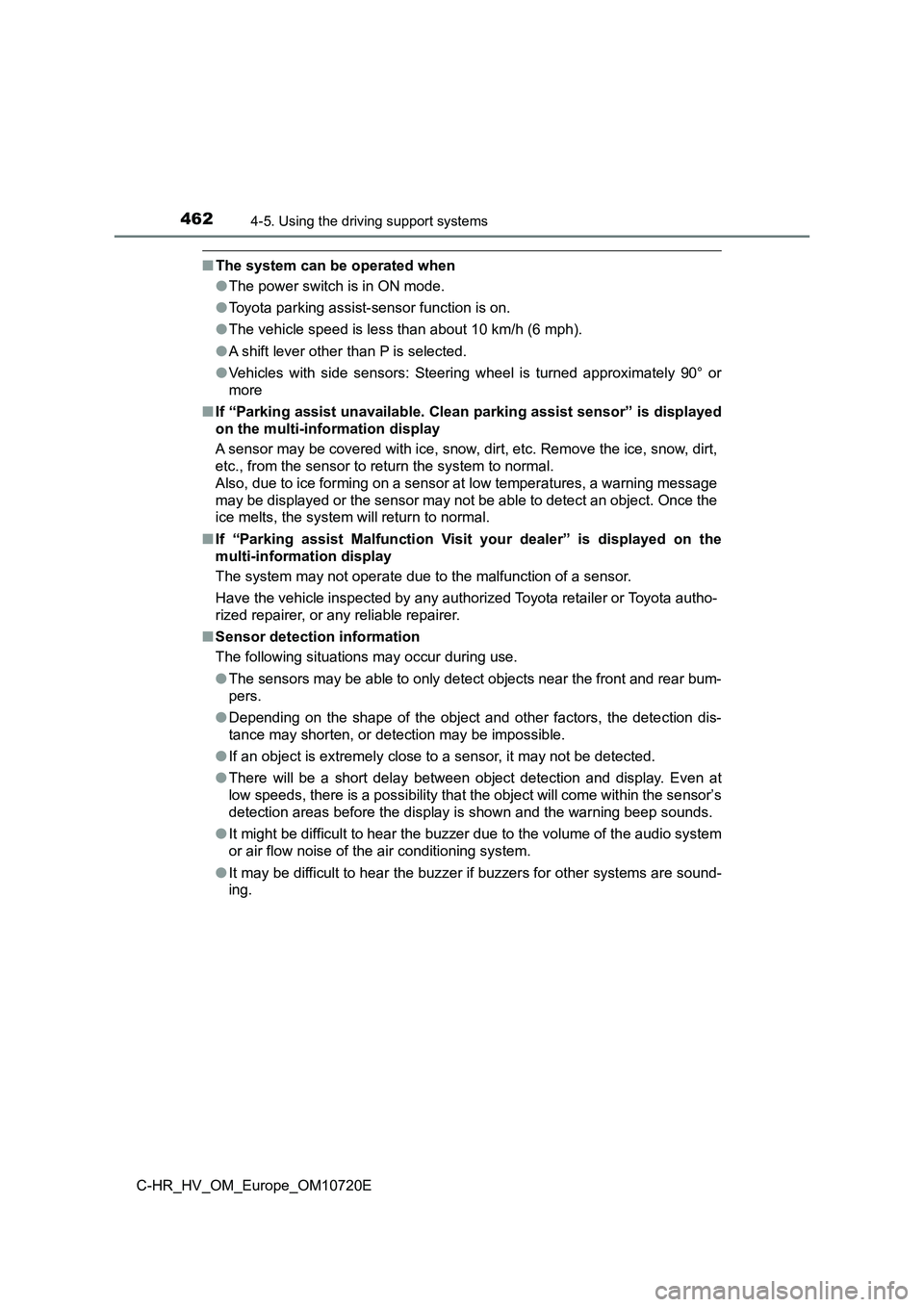
4624-5. Using the driving support systems
C-HR_HV_OM_Europe_OM10720E
■The system can be operated when
● The power switch is in ON mode.
● Toyota parking assist-sensor function is on.
● The vehicle speed is less than about 10 km/h (6 mph).
● A shift lever other than P is selected.
● Vehicles with side sensors: Steering wheel is turned approximately 90° or
more
■ If “Parking assist unavailable. Clean parking assist sensor” is displayed
on the multi-information display
A sensor may be covered with ice, snow, dirt, etc. Remove the i ce, snow, dirt,
etc., from the sensor to return the system to normal.
Also, due to ice forming on a sensor at low temperatures, a war ning message
may be displayed or the sensor may not be able to detect an obj ect. Once the
ice melts, the system will return to normal.
■ If “Parking assist Malfunction Visit your dealer” is displayed on the
multi-information display
The system may not operate due to the malfunction of a sensor.
Have the vehicle inspected by any authorized Toyota retailer or Toyota autho-
rized repairer, or any reliable repairer.
■ Sensor detection information
The following situations may occur during use.
● The sensors may be able to only detect objects near the front and rear bum-
pers.
● Depending on the shape of the object and other factors, the detection dis-
tance may shorten, or detection may be impossible.
● If an object is extremely close to a sensor, it may not be detected.
● There will be a short delay between object detection and display. Even at
low speeds, there is a possibility that the object will come wi thin the sensor’s
detection areas before the display is shown and the warning bee p sounds.
● It might be difficult to hear the buzzer due to the volume of the audio system
or air flow noise of the air conditioning system.
● It may be difficult to hear the buzzer if buzzers for other systems are sound-
ing.
Page 465 of 818
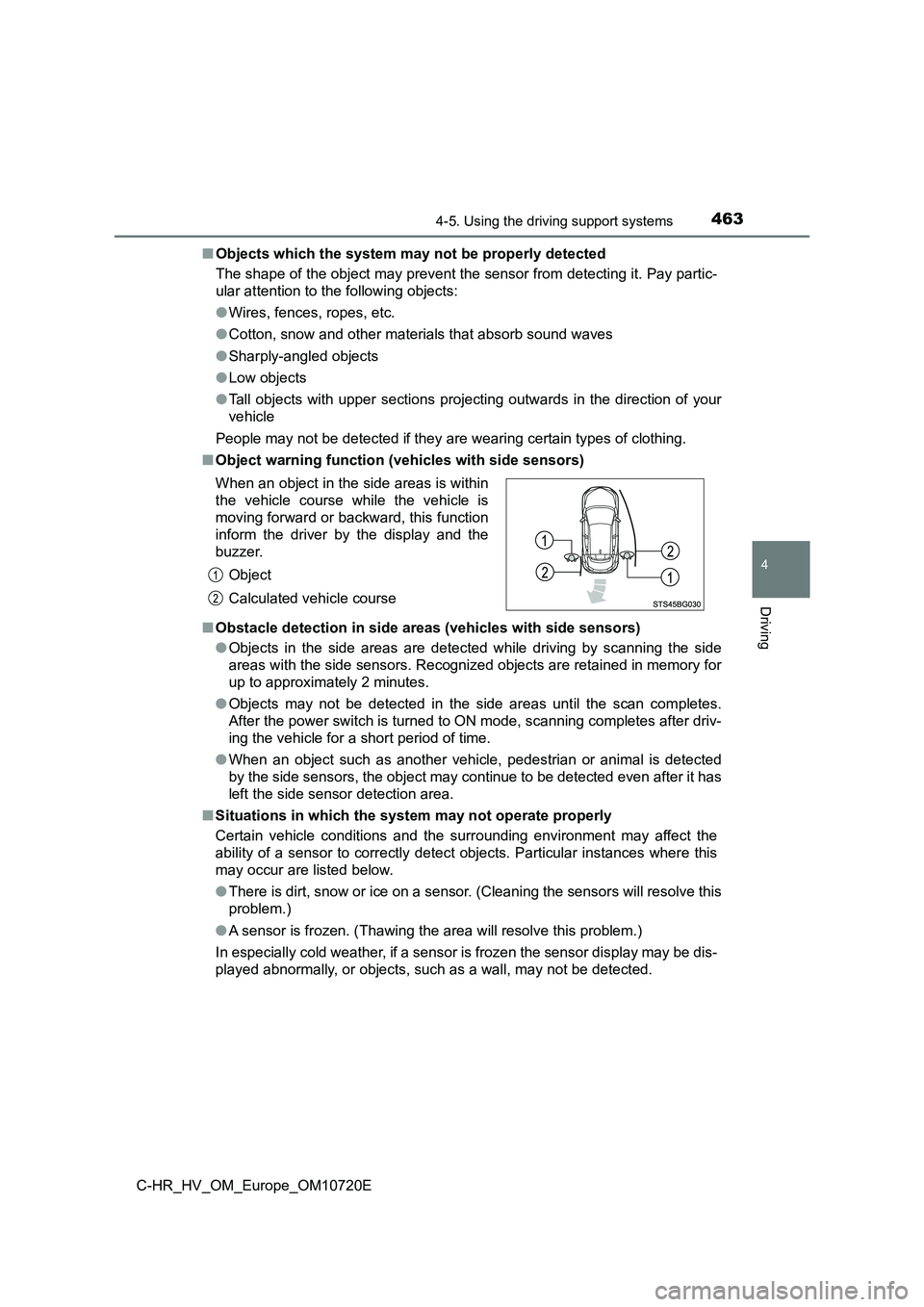
4634-5. Using the driving support systems
4
Driving
C-HR_HV_OM_Europe_OM10720E
■ Objects which the system may not be properly detected
The shape of the object may prevent the sensor from detecting i t. Pay partic-
ular attention to the following objects:
● Wires, fences, ropes, etc.
● Cotton, snow and other materials that absorb sound waves
● Sharply-angled objects
● Low objects
● Tall objects with upper sections projecting outwards in the direction of your
vehicle
People may not be detected if they are wearing certain types of clothing.
■ Object warning function (vehicles with side sensors)
■ Obstacle detection in side areas (vehicles with side sensors)
● Objects in the side areas are detected while driving by scanning the side
areas with the side sensors. Recognized objects are retained in memory for
up to approximately 2 minutes.
● Objects may not be detected in the side areas until the scan completes.
After the power switch is turned to ON mode, scanning completes after driv-
ing the vehicle for a short period of time.
● When an object such as another vehicle, pedestrian or animal is detected
by the side sensors, the object may continue to be detected eve n after it has
left the side sensor detection area.
■ Situations in which the system may not operate properly
Certain vehicle conditions and the surrounding environment may affect the
ability of a sensor to correctly detect objects. Particular ins tances where this
may occur are listed below.
● There is dirt, snow or ice on a sensor. (Cleaning the sensors will resolve this
problem.)
● A sensor is frozen. (Thawing the area will resolve this problem.)
In especially cold weather, if a sensor is frozen the sensor di splay may be dis-
played abnormally, or objects, such as a wall, may not be detec ted.
When an object in the side areas is within
the vehicle course while the vehicle is
moving forward or backward, this function
inform the driver by the display and the
buzzer.
Object
Calculated vehicle course
Page 466 of 818

4644-5. Using the driving support systems
C-HR_HV_OM_Europe_OM10720E
● On an extremely bumpy road, on an incline, on gravel, or on grass.
● When vehicle horns, vehicle detectors, motorcycle engines, air brakes of
large vehicles, the clearance sonar of other vehicles or other devices which
produce ultrasonic waves are near the vehicle
● A sensor is coated with a sheet of spray or heavy rain.
● If objects draw too close to the sensor.
● When a pedestrian is wearing clothing that does not reflect ultrasonic waves
(ex. skirts with gathers or frills).
● When objects that are not perpendicular to the ground, not perpendicular to
the vehicle traveling direction, uneven, or waving are in the d etection range.
● Strong wind is blowing
● When driving in inclement weather such as fog, snow or a sandstorm
● When an object that cannot be detected is between the vehicle and a
detected object
● If an object such as a vehicle, motorcycle, bicycle or pedestrian cuts in front
of the vehicle or runs out from the side of the vehicle
● If the orientation of a sensor has been changed due to a collision or other
impact
● When equipment that may obstruct a sensor is installed, such as a towing
eyelet, bumper protector (an additional trim strip, etc.), bicy cle carrier, or
snow plow
● If the front of the vehicle is raised or lowered due to the carried load
● If the vehicle cannot be driven in a stable manner, such as when the vehicle
has been in an accident or is malfunctioning
● When a tire chains, compact spare tire or an emergency tire puncture repair
kit is used
● When a sensor or the area around a
sensor is extremely hot or cold.
Page 467 of 818
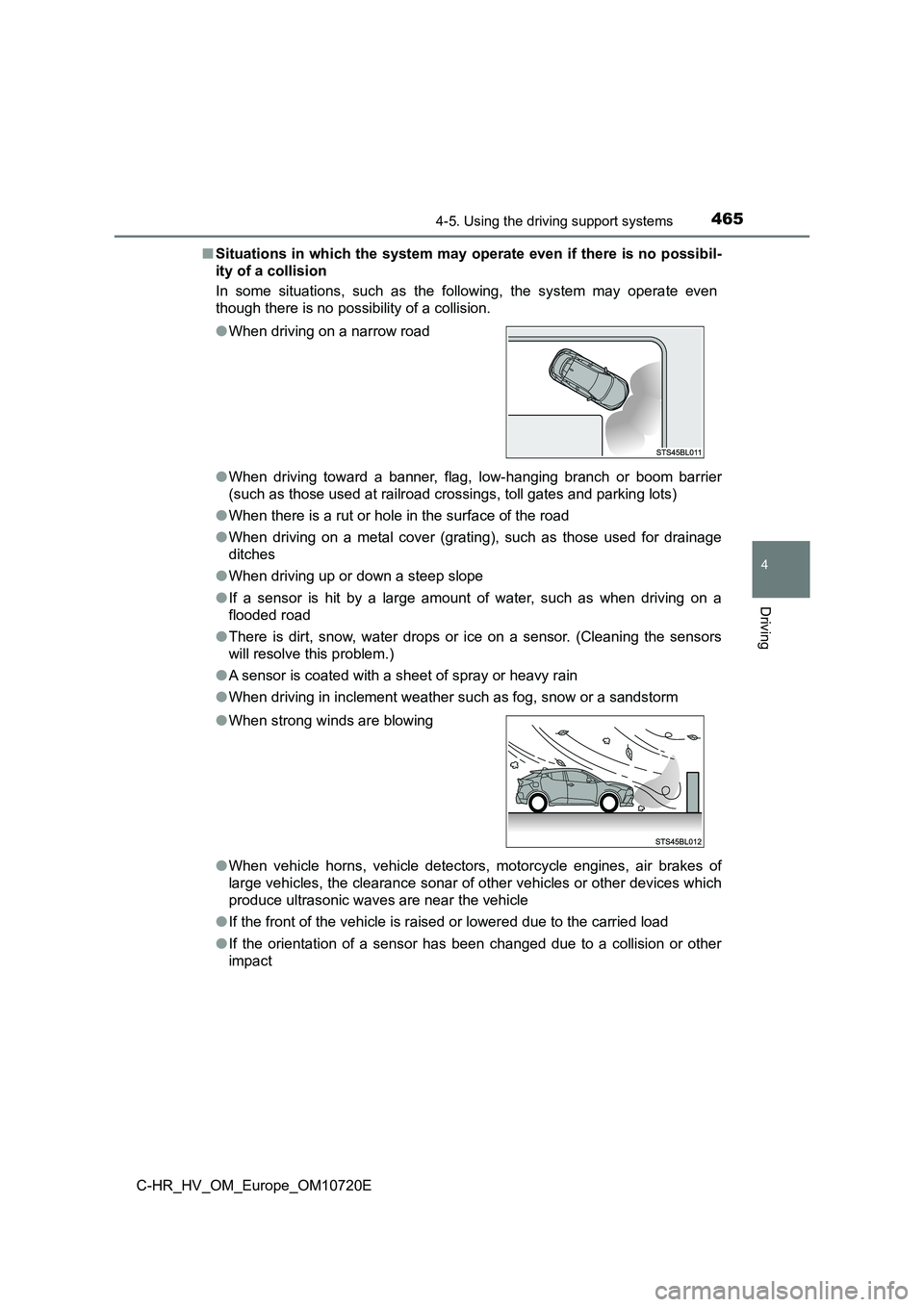
4654-5. Using the driving support systems
4
Driving
C-HR_HV_OM_Europe_OM10720E
■ Situations in which the system may operate even if there is no possibil-
ity of a collision
In some situations, such as the following, the system may opera te even
though there is no possibility of a collision.
● When driving toward a banner, flag, low-hanging branch or boom barrier
(such as those used at railroad crossings, toll gates and parki ng lots)
● When there is a rut or hole in the surface of the road
● When driving on a metal cover (grating), such as those used for drainage
ditches
● When driving up or down a steep slope
● If a sensor is hit by a large amount of water, such as when driving on a
flooded road
● There is dirt, snow, water drops or ice on a sensor. (Cleaning the sensors
will resolve this problem.)
● A sensor is coated with a sheet of spray or heavy rain
● When driving in inclement weather such as fog, snow or a sandstorm
● When vehicle horns, vehicle detectors, motorcycle engines, air brakes of
large vehicles, the clearance sonar of other vehicles or other devices which
produce ultrasonic waves are near the vehicle
● If the front of the vehicle is raised or lowered due to the carried load
● If the orientation of a sensor has been changed due to a collision or other
impact
● When driving on a narrow road
●When strong winds are blowing
Page 468 of 818
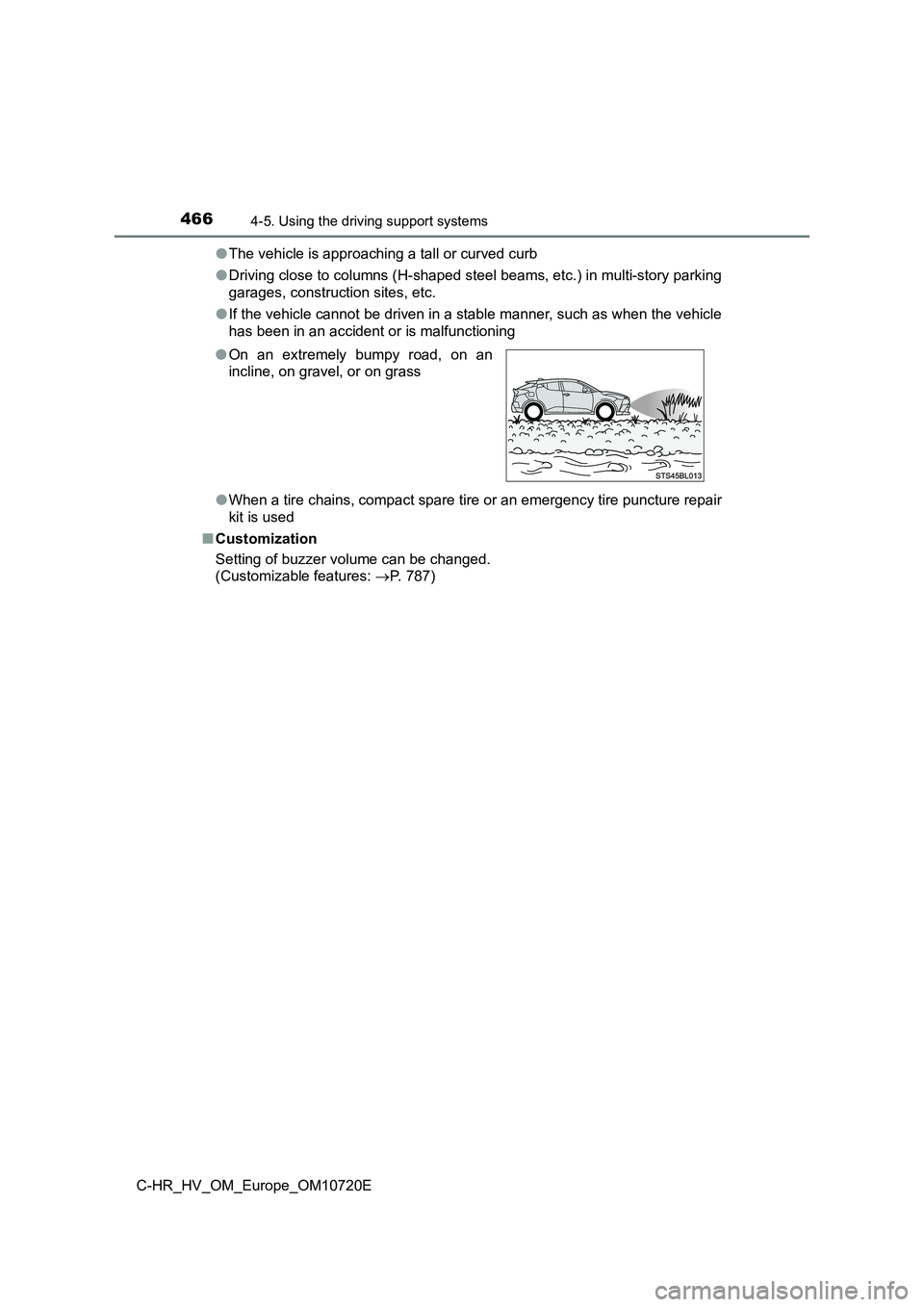
4664-5. Using the driving support systems
C-HR_HV_OM_Europe_OM10720E
● The vehicle is approaching a tall or curved curb
● Driving close to columns (H-shaped steel beams, etc.) in multi-story parking
garages, construction sites, etc.
● If the vehicle cannot be driven in a stable manner, such as when the vehicle
has been in an accident or is malfunctioning
● When a tire chains, compact spare tire or an emergency tire puncture repair
kit is used
■ Customization
Setting of buzzer volume can be changed.
(Customizable features: P. 787)
● On an extremely bumpy road, on an
incline, on gravel, or on grass
Page 469 of 818
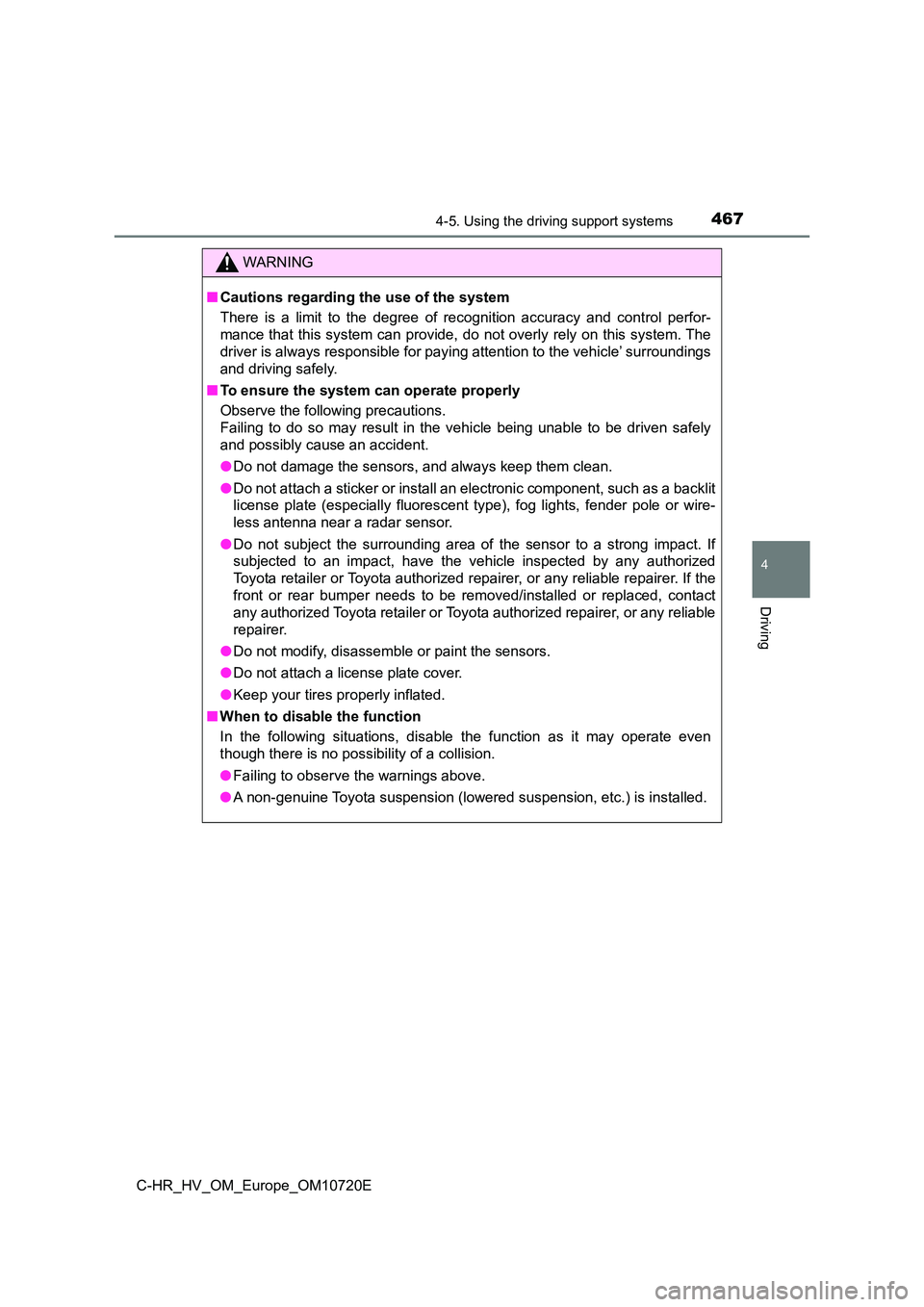
4674-5. Using the driving support systems
4
Driving
C-HR_HV_OM_Europe_OM10720E
WARNING
■Cautions regarding the use of the system
There is a limit to the degree of recognition accuracy and cont rol perfor-
mance that this system can provide, do not overly rely on this system. The
driver is always responsible for paying attention to the vehicl e’ surroundings
and driving safely.
■ To ensure the system can operate properly
Observe the following precautions.
Failing to do so may result in the vehicle being unable to be d riven safely
and possibly cause an accident.
● Do not damage the sensors, and always keep them clean.
● Do not attach a sticker or install an electronic component, such as a backlit
license plate (especially fluorescent type), fog lights, fender pole or wire-
less antenna near a radar sensor.
● Do not subject the surrounding area of the sensor to a strong impact. If
subjected to an impact, have the vehicle inspected by any autho rized
Toyota retailer or Toyota authorized repairer, or any reliable repairer. If the
front or rear bumper needs to be removed/installed or replaced, contact
any authorized Toyota retailer or Toyota authorized repairer, o r any reliable
repairer.
● Do not modify, disassemble or paint the sensors.
● Do not attach a license plate cover.
● Keep your tires properly inflated.
■ When to disable the function
In the following situations, disable the function as it may ope rate even
though there is no possibility of a collision.
● Failing to observe the warnings above.
● A non-genuine Toyota suspension (lowered suspension, etc.) is installed.
Page 470 of 818
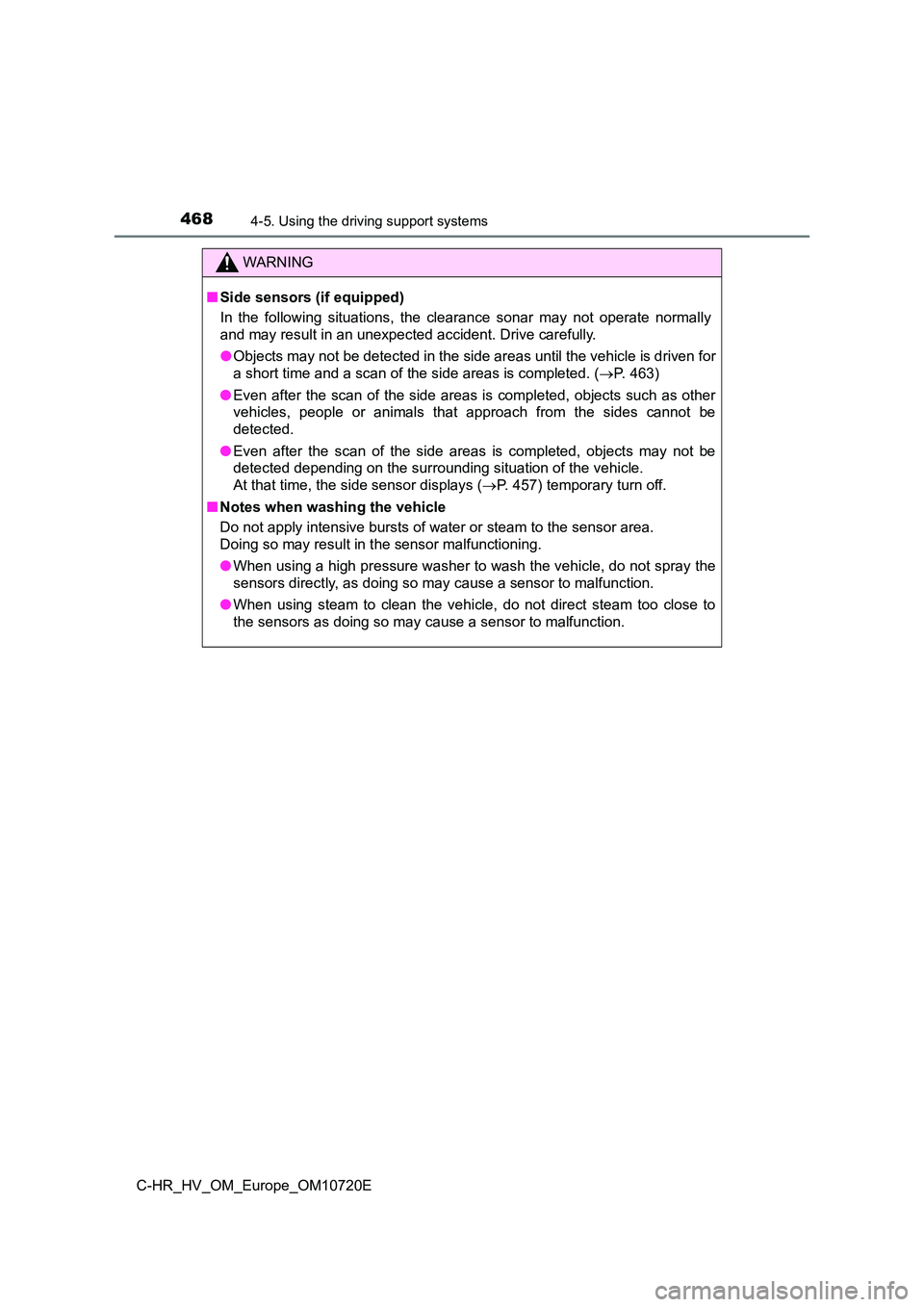
4684-5. Using the driving support systems
C-HR_HV_OM_Europe_OM10720E
WARNING
■Side sensors (if equipped)
In the following situations, the clearance sonar may not operat e normally
and may result in an unexpected accident. Drive carefully.
● Objects may not be detected in the side areas until the vehicle is driven for
a short time and a scan of the side areas is completed. ( P. 463)
● Even after the scan of the side areas is completed, objects such as other
vehicles, people or animals that approach from the sides cannot be
detected.
● Even after the scan of the side areas is completed, objects may not be
detected depending on the surrounding situation of the vehicle.
At that time, the side sensor displays ( P. 457) temporary turn off.
■ Notes when washing the vehicle
Do not apply intensive bursts of water or steam to the sensor a rea.
Doing so may result in the sensor malfunctioning.
● When using a high pressure washer to wash the vehicle, do not spray the
sensors directly, as doing so may cause a sensor to malfunction.
● When using steam to clean the vehicle, do not direct steam too close to
the sensors as doing so may cause a sensor to malfunction.